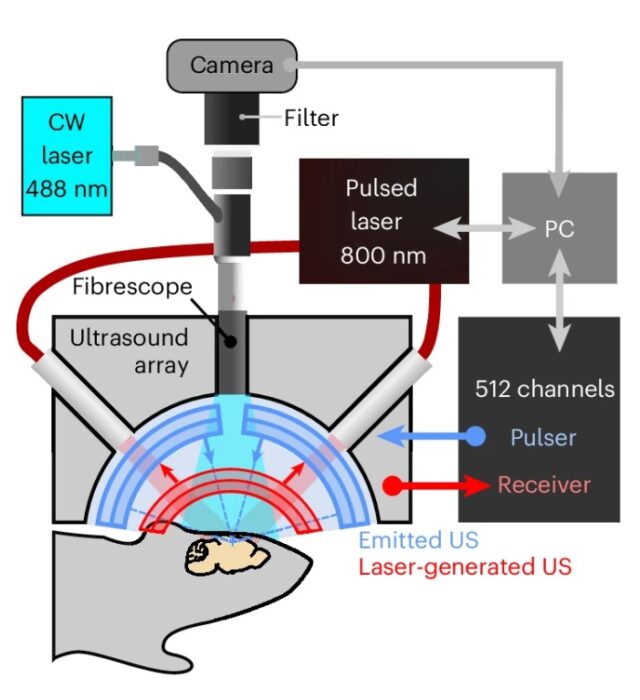Oct 06 2025
Using Sound to Modulate the Brain
 The technique is called holographic transcranial ultrasound neuromodulation – which sounds like a mouthful but just means using multiple sound waves in the ultrasonic frequency to affect brain function. Most people know about ultrasound as an imaging technique, used, for example, to image fetuses while still in the womb. But ultrasound has other applications as well.
The technique is called holographic transcranial ultrasound neuromodulation – which sounds like a mouthful but just means using multiple sound waves in the ultrasonic frequency to affect brain function. Most people know about ultrasound as an imaging technique, used, for example, to image fetuses while still in the womb. But ultrasound has other applications as well.
Sound wave are just another form of directed energy, and that energy can be used not only to image things but to affect them. In higher intensity they can heat tissue and break up objects through vibration. Ultrasound has been approved to treat tumor by heating and killing them, or to break up kidney stones. Ultrasound can also affect brain function, but this has proven very challenging.
The problem with ultrasonic neuromodulation is that low intensity waves have no effect, while high intensity waves cause tissue damage through heating. There does not appear to be a window where brain function can be safely modulated. However, a new study may change that.
The researchers are developing what they call holographic ultrasound neuromodulation – they use many simultaneous ultrasound origin points that cause areas of constructive and destructive interference in the brain, which means there will be locations where the intensity of the ultrasound will be much higher. The goal is to activate or inhibit many different points in a brain network simultaneously. By doing this they hope to affect the activity of the network as a whole at low enough intensity to be safe for the brain.
The study was essentially a proof of concept, just showing that the technique works without looking at any specific clinical outcome. And they found that it works (I probably would not be writing about it if it didn’t.) They were able to affect brain function with an ultrasound intensity one order of magnitude lower than usual. That is a game-changer for this technology.
The ultrasound works primarily by affecting the proteins that are part of ion channels on the surface of neurons. These are pores that control the flow of ions, like sodium, potassium, chloride, and calcium, from inside to outside the cell, and vice versa. Many of these pores are dynamic, changing in response to local conditions. For example, a voltage-gated sodium channel will open or close in response to local electrical activity. Altering the function of these ion channels can make a neuron more or less active, causing it to spontaneously fire or keep it from firing. In this way the researchers hope to either activate or inhibit entire networks within the brain.
There are two main types of uses for this technology. The first is to study brain function. If we can turn off or activate a brain network, then we can determine what that network does. It also helps us confirm what the networks in the brain are. This technology is perhaps best suited for this because it can simultaneously image the network and affect its function.
We can currently do this with electrical or magnetic stimulation. These use a very similar principle, tuning fields of electromagnetic energy so that they either stimulate or inhibit specific points in the brain. My searches indicate that the holographic technique has not been applied so far to, for example, transcranial magnetic stimulation. I wonder if this technique will translate to that technology. It remains to be seen if the ultrasound technique will be as good or superior to magnetic or electrical stimulation. It also has the potential advantage of simultaneously imaging the network, which should make research easier.
The other potential application is to affect brain function clinically, to treat a disease. The low hanging fruit for such neuromodulation is inhibiting seizures or suppressing tremors (which are already targets of neuromodulation). Other applications require a bit more sophisticated knowledge of brain networks, which is why this research helps advance clinical applications. Other targets of neuromodulation with positive effects include depression, anxiety, and substance use. There is also a lot of early work in conditions like migraines.
Even if neuromodulation does not expand much beyond these early targets, it can prove to be a very useful treatment option, especially for those who do not respond to medication or cannot tolerate the side effects. But the real promise of neuromodulation is that there is no theoretical limit to its potential applications.
Pharmacological therapy has a theoretical limit – we can only affect receptors or therapeutic targets that already exist within the brain, and drugs cannot be more targeted than the receptors themselves. In other words, if we want to increase the activity of dopamine using a drug, we can affect dopamine activity in several way, but dopamine is used in many different parts of the brain for many functions. We cannot specifically target only the one dopamine function we want. We have discovered dopamine subtypes, so we can get somewhat selective, but only as much as the existing biology allows.
With neuromodulation there is no such limit. We can activate or inhibit any network in the brain. The only limit is our knowledge of brain function and the precision of our technology. Neuromodulation techniques are all tunable already – we have a lot of control over their frequency, intensity, and location. The holographic technique gives us even more precision.
As the technology develops we will likely be able to alter brain function in more subtle and sophisticated ways. This could have profound implications for all psychiatric conditions, pain, and many neurological conditions. We could develop drugless anesthesia.
I do wonder how precise the transcranial techniques could get. Could this evolve into a non-invasive form of not just neuromodulation but brain-machine interface? Could one day someone put on a cap with hundreds of ultrasound producers, and that cap function as a neural interface? And since networks can also be imaged, this could theoretically function for two-way communication. It could then be used for any form of brain-machine interface, such as controlling robotic prosthetics. It could also function as a form of “neuro-reality” – like virtual reality but instead of putting on goggles the computer directly communicates to your brain. I would love to see where this technology will be in 100 or 500 years.
It is sad that in the short term this research is being slowed by the short-sighted political imperatives of our current administration. This research is largely funded by the NIH. It is also a result of an international collaboration of scientists from different institutions (as much of high-level neurological research is). As one of the authors notes:
“This study and the collaboration with researchers from New York University were principally financed by the United States National Institutes of Health. As this agency is currently under political pressure and is no longer awarding funding to international research partners, it is presently not possible for the researchers to continue their collaboration within the same framework.”






